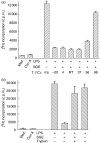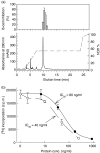Characterization of the B-cell inhibitory protein factor in Ixodes ricinus tick saliva: a potential role in enhanced Borrelia burgdoferi transmission
- PMID: 15500628
- PMCID: PMC1782588
- DOI: 10.1111/j.1365-2567.2004.01975.x
Characterization of the B-cell inhibitory protein factor in Ixodes ricinus tick saliva: a potential role in enhanced Borrelia burgdoferi transmission
Abstract
We recently described the inhibition of host B lymphocytes by Ixodes ricinus tick saliva. In this study, we characterized the factor responsible for this activity and examined the modulation of lipopolysaccharide (LPS)- and Borrelia burgdorferi outer surface protein (Osp)-induced proliferation of naive murine B lymphocytes by an enriched fraction of this factor. The B-lymphocyte inhibitory activity was destroyed by trypsin treatment, indicating that a proteinaceous factor was responsible for this activity. The removal of glutathione-S-transferase (GST) from tick salivary glands extracts (SGE) showed that this B-cell inhibitory protein (BIP) was not a GST. Gel filtration liquid chromatography indicated that BIP has a native molecular weight of approximately 18,000. An enrichment protocol, using a combination of anion-exchange and reverse-phase liquid chromatography, was established. BIP-enriched fractions did not suppress T-cell proliferation. Delayed addition of BIP-enriched fractions, up to 7 hr after LPS addition, inhibited the proliferation of isolated B cells. BIP-enriched fractions dramatically inhibited both OspA- and OspC-induced proliferation of isolated B cells. These results strongly suggest that BIP may facilitate B. burgdorferi transmission by preventing B-cell activation, and also highlights the potential of BIP as a therapeutic agent in B-cell maladies.
Figures







References
-
- Thompson C, Spielman A, Krause PJ. Coinfecting deer-associated zoonoses. Lyme disease, babesiosis, and ehrlichiosis. Clin Infect Dis. 2001;33:676–85. - PubMed
-
- Stanek G, Strle F. Lyme borreliosis. Lancet. 2003;362:1639–47. - PubMed
-
- Labuda M, Jones LD, Williams T, Nuttall PA. Enhancement of tick-borne encephalitis virus transmission by tick salivary gland extracts. Med Vet Entomol. 1993;7:193–6. - PubMed
-
- Zeidner NS, Schneider BS, Nuncio MS, Gern L, Piesman J. Coinoculation of Borrelia spp. with tick salivary gland lysate enhances spirochete load in mice and is tick species-specific. J Parasitol. 2002;88:1276–8. - PubMed
Publication types
MeSH terms
Substances
LinkOut - more resources
Full Text Sources
Other Literature Sources
Medical
Research Materials
